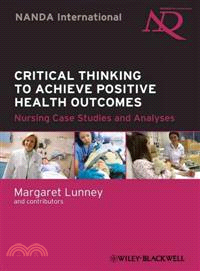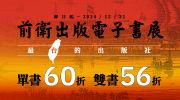Critical Thinking, Nursing Diagnosis, Interventionand Outcomes
商品資訊
ISBN13:9780813816012
出版社:John Wiley & Sons Inc
作者:Lunney
出版日:2009/06/12
裝訂/頁數:平裝/388頁
商品簡介
作者簡介
目次
相關商品
商品簡介
This book uses the latest research findings to apply critical thinking processes for the development of diagnostic reasoning and the selection of patient outcomes and nursing interventions.Four chapters describe the meaning of intelligence, critical thinking, and application of critical thinking processes within nursing. The case studies and their ultimate resolution to intervention and outcome illustrate these processes by enabling repeated practice. Case studies are organized into four sections; problem diagnoses, risk diagnoses, health promotion diagnoses, and strength diagnoses. A companion website provides on-line resources.
作者簡介
Margaret Lunney, RN, PhD, Professor and Graduate Programs Coordinator, College of Staten Island, Staten Island, NY, Doctoral Faculty, Graduate Center, City University of New York, New York, NY, USA.
目次
PART I.
1 Use of Critical Thinking to Achieve Positive Health Outcomes.
2 Diagnostic Reasoning and Accuracy of Diagnosing Human Responses.
3 Guiding Principles for Use of Nursing Diagnoses and NANDA-I, NOC and NIC.
4 Apply the Guiding Principles and Directions for Use of NANDA-I, NOC and NIC.
PART II: Case Studies: Opportunities to Practice Critical Thinking.
Use of Critical Thinking with Each Case Study.
Abbreviations Used in the Case Studies.
5 Problem Diagnoses and Associated Outcomes and Nursing Interventions.
5.1 Woman Admitted for Diagnostic Testing of a Lung Nodule.
5.2 Adaptation to the Pain of a Fractured Hip.
5.3 Acute Presentation of an Elderly Woman with Cancer.
5.4 Substance Abuse Crisis Associated with Stress Overload.
5.5 Communication of Perceptions and Mechanical Ventilation.
5.6 Preparing for Orthopedic Surgery with Other Health Problems.
5.7 Helping a School Child with Asthma.
5.8 Birth of a 25 week Neonate.
5.9 Man with Severe Burns.
5.10 Dilemma of Addressing Overlapping Diagnoses in Acute Care.
5.11 The Hypermetabolic State.
5.12 Low Accuracy Nursing and Medical Diagnoses Can Lead to Harm.
5.13 Cardiac Disease and Self Management.
5.14 Woman with a Neurological Problem.
5.15 Orthopedic Care of a Woman with Total Hip Replacement.
5.16 Using Orem's Theory for Care of a Woman with Terminal Cancer.
5.17 Cardiac Disease and Anticoagulation Therapy.
5.18 Diabetes Self Management when Other Family Members Need Care.
5.19 Impetus of Diabetic Crisis to Improve Self Management.
5.20 Self Management of Diabetes and Stress.
5.21 Telephone Nurse Advice and an AIDS-Related Crisis.
5.22 Woman who Experienced a Significant Childhood Loss.
5.23 Young Woman Whose Mother is Dying.
5.24 Rehabilitation of a Male with a Young Family after a Stroke.
5.25 Elderly Woman Who Thinks She Should Not be Discharged.
5.26 Elderly Man Who is Angry.
5.27 Homeless Woman's Reaction to Loss.
5.28 Family Stress and Alzheimer's Disease.
5.29 Family Struggling with Ostomy Care at Home.
5.30 Nonparticipation in Rehabilitation with a Colostomy.
5.31 Man with Urinary Incontinence After Prostrate Surgery.
5.32 Palliative Care and the Outcome of Comfort.
5.33 Hospice and Palliative Care.
5.34 Two-Year-Old Bess's Response to Parents' Divorce.
5.35 Challenges in Helping a Person to Accept Long Term Care.
5.36 Woman with a History of Being Battered.
5.37 Woman in Labor with Complications.
5.38 Breast feeding and Postpartum Nursing.
5.39 Business Woman with Stress in her Personal Life.
6. Risk Diagnoses and Associated Outcomes and Nursing Interventions.
6.1 Role of Nurses in the Protection of Children.
6.2 Responses to Mechanical Ventilation.
6.3 Family Caregiving at End of Life.
6.4 Man with Renal Calculi and Stent Placement.
6.5 Helping a Man with Low Literacy.
6.6 Self Management of Chronic Illness and Financial Status.
6.7 Case Management for Homeless Man with Severe Pancreatitis.
6.8 Psychiatric Care of an Adult Male with Poor Impulse Control.
6.9 Response to a diagnosis of chronic illness.
7. Health Promotion Diagnoses and Associated Outcomes and Nursing Interventions.
7.1 Support of a Mexican-American Woman in Postpartum Care.
7.2 Parenting of a child with Spina Bifida.
7.3 Woman Who Experienced Early Childhood Trauma.
7.4 Living with Multiple Health Problems.
7.5 Response to Limitations Associated with Cardiac Disease.
7.6 Living with Chronic Obstructive Pulmonary Disease.
8. Strength Diagnoses and Associated Outcomes and Nursing Interventions.
8.1 Mother Breastfeeding Her Newborn 8.2 Nursing Communication for Continuity of Care.
Appendixes.
A. The Lunney Scoring Method for Accuracy.
B. Nursing Diagnosis Accuracy Scale.
C. Webliography.
1 Use of Critical Thinking to Achieve Positive Health Outcomes.
2 Diagnostic Reasoning and Accuracy of Diagnosing Human Responses.
3 Guiding Principles for Use of Nursing Diagnoses and NANDA-I, NOC and NIC.
4 Apply the Guiding Principles and Directions for Use of NANDA-I, NOC and NIC.
PART II: Case Studies: Opportunities to Practice Critical Thinking.
Use of Critical Thinking with Each Case Study.
Abbreviations Used in the Case Studies.
5 Problem Diagnoses and Associated Outcomes and Nursing Interventions.
5.1 Woman Admitted for Diagnostic Testing of a Lung Nodule.
5.2 Adaptation to the Pain of a Fractured Hip.
5.3 Acute Presentation of an Elderly Woman with Cancer.
5.4 Substance Abuse Crisis Associated with Stress Overload.
5.5 Communication of Perceptions and Mechanical Ventilation.
5.6 Preparing for Orthopedic Surgery with Other Health Problems.
5.7 Helping a School Child with Asthma.
5.8 Birth of a 25 week Neonate.
5.9 Man with Severe Burns.
5.10 Dilemma of Addressing Overlapping Diagnoses in Acute Care.
5.11 The Hypermetabolic State.
5.12 Low Accuracy Nursing and Medical Diagnoses Can Lead to Harm.
5.13 Cardiac Disease and Self Management.
5.14 Woman with a Neurological Problem.
5.15 Orthopedic Care of a Woman with Total Hip Replacement.
5.16 Using Orem's Theory for Care of a Woman with Terminal Cancer.
5.17 Cardiac Disease and Anticoagulation Therapy.
5.18 Diabetes Self Management when Other Family Members Need Care.
5.19 Impetus of Diabetic Crisis to Improve Self Management.
5.20 Self Management of Diabetes and Stress.
5.21 Telephone Nurse Advice and an AIDS-Related Crisis.
5.22 Woman who Experienced a Significant Childhood Loss.
5.23 Young Woman Whose Mother is Dying.
5.24 Rehabilitation of a Male with a Young Family after a Stroke.
5.25 Elderly Woman Who Thinks She Should Not be Discharged.
5.26 Elderly Man Who is Angry.
5.27 Homeless Woman's Reaction to Loss.
5.28 Family Stress and Alzheimer's Disease.
5.29 Family Struggling with Ostomy Care at Home.
5.30 Nonparticipation in Rehabilitation with a Colostomy.
5.31 Man with Urinary Incontinence After Prostrate Surgery.
5.32 Palliative Care and the Outcome of Comfort.
5.33 Hospice and Palliative Care.
5.34 Two-Year-Old Bess's Response to Parents' Divorce.
5.35 Challenges in Helping a Person to Accept Long Term Care.
5.36 Woman with a History of Being Battered.
5.37 Woman in Labor with Complications.
5.38 Breast feeding and Postpartum Nursing.
5.39 Business Woman with Stress in her Personal Life.
6. Risk Diagnoses and Associated Outcomes and Nursing Interventions.
6.1 Role of Nurses in the Protection of Children.
6.2 Responses to Mechanical Ventilation.
6.3 Family Caregiving at End of Life.
6.4 Man with Renal Calculi and Stent Placement.
6.5 Helping a Man with Low Literacy.
6.6 Self Management of Chronic Illness and Financial Status.
6.7 Case Management for Homeless Man with Severe Pancreatitis.
6.8 Psychiatric Care of an Adult Male with Poor Impulse Control.
6.9 Response to a diagnosis of chronic illness.
7. Health Promotion Diagnoses and Associated Outcomes and Nursing Interventions.
7.1 Support of a Mexican-American Woman in Postpartum Care.
7.2 Parenting of a child with Spina Bifida.
7.3 Woman Who Experienced Early Childhood Trauma.
7.4 Living with Multiple Health Problems.
7.5 Response to Limitations Associated with Cardiac Disease.
7.6 Living with Chronic Obstructive Pulmonary Disease.
8. Strength Diagnoses and Associated Outcomes and Nursing Interventions.
8.1 Mother Breastfeeding Her Newborn 8.2 Nursing Communication for Continuity of Care.
Appendixes.
A. The Lunney Scoring Method for Accuracy.
B. Nursing Diagnosis Accuracy Scale.
C. Webliography.
主題書展
更多
主題書展
更多書展今日66折
您曾經瀏覽過的商品
購物須知
外文書商品之書封,為出版社提供之樣本。實際出貨商品,以出版社所提供之現有版本為主。部份書籍,因出版社供應狀況特殊,匯率將依實際狀況做調整。
無庫存之商品,在您完成訂單程序之後,將以空運的方式為你下單調貨。為了縮短等待的時間,建議您將外文書與其他商品分開下單,以獲得最快的取貨速度,平均調貨時間為1~2個月。
為了保護您的權益,「三民網路書店」提供會員七日商品鑑賞期(收到商品為起始日)。
若要辦理退貨,請在商品鑑賞期內寄回,且商品必須是全新狀態與完整包裝(商品、附件、發票、隨貨贈品等)否則恕不接受退貨。
























